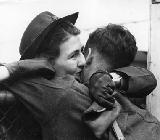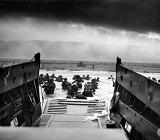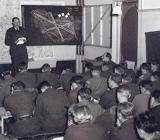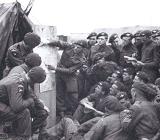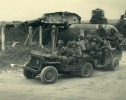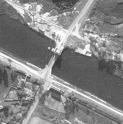The British Airborne Assault
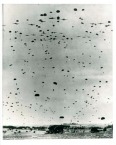
Para re-supply drop
If there was going to be a large German counterattack on or shortly after D-Day, the Allies expected it to come from the east where the Germans were known to have strong armoured reserves. The job of protecting this vulnerable left flank of the Allied landing zone just to the east of Sword Beach fell to the British 6th Airborne Division. Like their American paratrooper counterparts, the tasks given to the British forces here mainly involved capturing key crossroads and villages as well as bridges, the most famous of which is now called “Pegasus Bridge”. They were also tasked with blowing up the key bridges that any German counterattack would have to use to pass over the river Dives, as well as gun batteries that the Germans had sited overlooking the eastern flank of Sword Beach. Despite problems with scattered drops of Para's up to ten miles (16km) off course and fighting units running as low as ten percent of normal strength, the jobs were done and the Eastern flank was secured before the seaborne landings started.

Airborne Drop Zones
This landing was very scattered, some Paratroopers landing up to 15 miles off course. This was due to low cloud cover, German anti-aircraft fire and smoke covering the ground caused by the Allies own pre-invasion bombardments, all causing aircraft pilots to be unable to find their assigned drop zones. Despite this, enough of the Paratroopers landed close enough to their targets to accomplish the most critical of their missions, but their reduced numbers limited the scope of their operations severely. The German response here was rapid and the threat of the German armour of the 21st Panzer Division which know to be in the vicinity of Caen and Sword Beach also induced a tendency to cautiousness. This was a threat that did not have to be considered by their American Paratrooper partners behind Utah Beach.
The Battle Sites/Sights
Pegasus Bridge
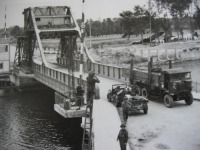
Gliders behind Pegasus Bridge
The assault on Pegasus Bridge on the morning of June 6th, 1944, is probably one of the most famous af all of the operations carried out on D-Day. Pegasus Bridge spans the Caen canal, and along the sixteen kilometers (10 miles) of the canal running due north from Caen, this was the only bridge which spanned the waterway. In the hands of the Allies, this bridge could be used to ferry reinforcements and supplies to the British Airborne forces east of the Orne river. Also called for in the plan was that if captured intact then the docks at Caen, ten miles inland, could be used to supply the British forces after the capture of the city on D-Day.
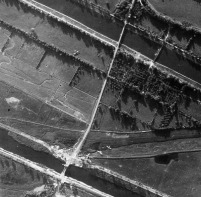
Pegasus Bridge after the Assault
It was decided to use one hundred and eighty men of the British 6th Airborne Division to be flown in on six gliders to seize the targets. In order to maintain the surprise, this was to be the first airborne operation to be carried out on D-Day. In a superb display of flying, the glider pilots put their three gliders down right beside their target, the closest only forty seven meters (one hundred and forty seven feet) from the bridge. The bridge was secured within fifteen minutes with only two of the attacking force killed, and a security perimeter was set up at the road junctions just east and west of the bridge. Despite a pre-dawn armoured counter-attack by the Germans, the Paratroopers held their positions until just after noon on D-Day when the arrival of the Commando Brigade led by Lord Lovat coming from Sword Beach arrive only five minutes behind schedule.
The Merville Battery
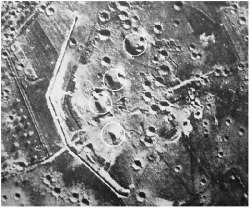
Merville Battery with the Gun Bunkers circled
Now a museum, here you will be shown the German Gun Battery that was sited to shoot along the whole length of the Sword Beach. This battery was strongly protected against attack from a seaward direction and thought to contain guns of about 150mm (six inches) caliber capable of causing huge damage to the proposed amphibious landings on D-day's Eastern-most flank. As it was not considered assaultable from the coast, it was assigned as the main D-Day target of the 9th Battalion of the British Parachute Regiment under the command of Lt -Colonel Terence Ottway. After the RAF had unloaded their pre-invasion “softening up” bombing mission the Paratroopers would commence their attack. But things would go wrong from the start. As you drive up to the battery you will go past the 9th Battalion's assembly area where you will be shown where this bombing mission would almost completely miss the battery, but fall dangerously close to the assembling assault troops. Of the six hundred and fifty men assigned to the task of destroying the battery, only about 150 had assembled by the time the attack had to go in. You will then see where after clearing the perimeter minefield by hand and bayonet, where the audacious assault in which this small group of assorted paratroopers subdued the German defenders went in. But, having captured the battery, the soldiers discovered that the guns in the casemates were not the six inch monsters they had expected, but much smaller 75mm (3-inch) caliber guns, barely capable of even firing as far as Sword beach's Easternmost point. However, despite all the problems, the assault had worked perfectly, and finally, as was part of the original plan, the Paratroopers withdrew, abandoning the battery to be taken over again by it's German builders. It was not to be permanently in Allied hands until it was captured again several weeks later.
Ranville
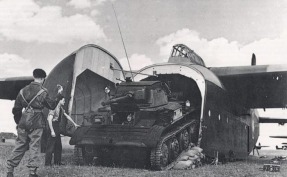
Unloading a Tetrarch tank from a Hamilcar glider
Here you will see the village of Ranville was an objective of the British 6th (Airborne) Division on the morning of 6th June 1944, and was captured by units of this formation on the morning of D Day. The churchyard of this village was also used for immediate burials, and is now the site of the larger permanent British Commonwealth cemetery. The first paratroopers approached the village at about 2:30am on the morning of June 6th, clearing out the German Company of the 125th Panzer Grenadier that was stationed there. The village was cleared by about 4:30am and was to serve as the command post of General Gale, commander of the 6th Airborne Division. The lower village of Ranville was attacked by about one hundred Germans and two self-propelled guns shortly after dawn, but the attack was beaten off by the Paratroopers. A major counter-attack by three thousand German soldiers and one hundred and twenty tanks had been organized by the Germans for 11am, but as this attack was about to be launched the German Commander received orders to attack to the west of Caen. After this attack was called off, the upper part of the village was never seriously threatened again, but the lower village was attacked numerous times by German armoured elements. You can also see several plaques and memorials to the paratroopers that are found around the village.
Le Mesnil Crossroads
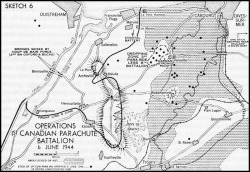
Canadian Parachute Batt. Operations, D-Day
After they had blown up the two bridges east of their Drop Zone, 'V', the target of the 1st Canadian Parachute Battalion was the crossroads at le Mesnil. Sitting astride the strategically important crossroads junction, this point on the Bavent ridge gave the occupiers views in all directions, not only east, north and south to the German positions, but also west to the left flank of the Allied seaborne invasion. For this reason it was not only important to hold the position for the uninterrupted views of the German positions, but also to deny it's vantage point to the Germans. There were strong elements of the German 21st Panzer Division in the area and these were a threat on D-Day, but never approached the crossroads. The German counter attacks would come over the following days, but despite repeated attacks, the Canadians would hold the position against numerous armoured counterattacks mounted by the Germans, destroying several tanks in the process.
